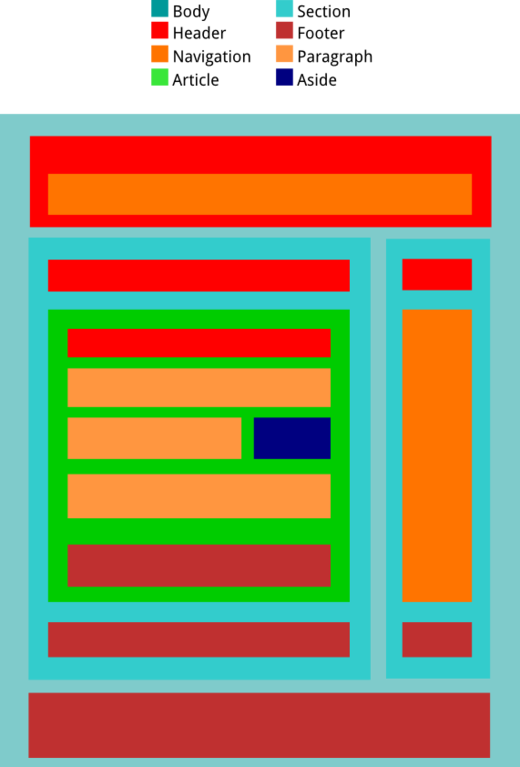Wait a minute how do we figure out the CSS for this and where exactly do we put "section" in our html5 document?
Block Elements
There are several primary block elements used in HTML5. We will look at some new and old tags that complement the <head> and <body> duo.
- <header>
- <nav>
- <article>
- <aside>
- <footer>
- <blockquote>
<header>
The <header> tag is a container for introductory materials in a document or section. <header> can be used multiple times in a document and usually contains at least one <h1>-<h6> element (in order to validate).
<header> <h1>Section/Document Header</h1> <p>A brief description of this section/document</p> </header>
Further reading:
- HTML5 Doctor: The <header> Element
- w3schools: HTML5 <header>
<nav>
The <nav> tag is used to demarcate a section containing navigation anchors (links) to other content or sections. The anchors can be nested within a list such as an unordered list <ul>.
<nav>
<h1>Navigation</h1>
<ul>
<li><a href="#home">Home</a></li>
<li><a href="#contact">Contact Us</a></li>
</ul>
</nav>
Further reading:
- w3schools: HTML5 <nav>
- HTML5 Doctor: <nav>
- w3c: <nav> Specification
<article>
The <article> tag designates a region of a document that is self-contained. <article> can be an article, blog post, news story, etc.
<article> <img src="image.webp" alt="An image." /> This is the content for the article. </article>
Further reading:
- HTML5 Doctor: The article element
- w3c: The article element
- w3schools: HTML5 <article>
<aside>
The <aside> tag contains information that is tangentially related to to the primary content. Examples can include anecdotes, sidebars, external links, keyword definitions, etc.
<article>
<p>This is an article HTML5</p>
<aside>
HTML5 is often used in conjunction with CSS and JavaScript.
</aside>
</article>
Further reading:
- HTML5 Doctor: Aside revisited
- w3c: The aside element
- w3schools: HTML5 aside tag
<footer>
The <footer> element is located at the end of a content section, such as <html>, and will contain information including licensing details, addresses and contact information, and links to site-wide documents such as a community aggreement.
<html> <article>Article content.</article> <footer> Creative Commons license. </footer> </html>
Further reading:
- HTML5 Doctor: The footer element
- w3c: The footer element
- w3schools: HTML5 footer tag
<blockquote>
The <blockquote> tag is used to indicate a quotation or citation. The cite attribute is used within a <blockquote> tag to reference the origin of the quote.
<blockquote cite="Caleb">on the last element you listed 'bockquote', should be blockquote</blockquote>
Further reading:
- w3c: The blockquote element
- w3schools: HTML5 blockquote tag
Task
- Put together a news article using each of the above tags and any tags described in previous tasks.
- Post a link to your news article in the discussion area below.
- Be sure to review each others' news articles and comment on techniques and content as desired :-)
Hint: Use the following diagram as an example of how block elements are nested.
Note: CSS is required to obtain the layout in the following diagram.





